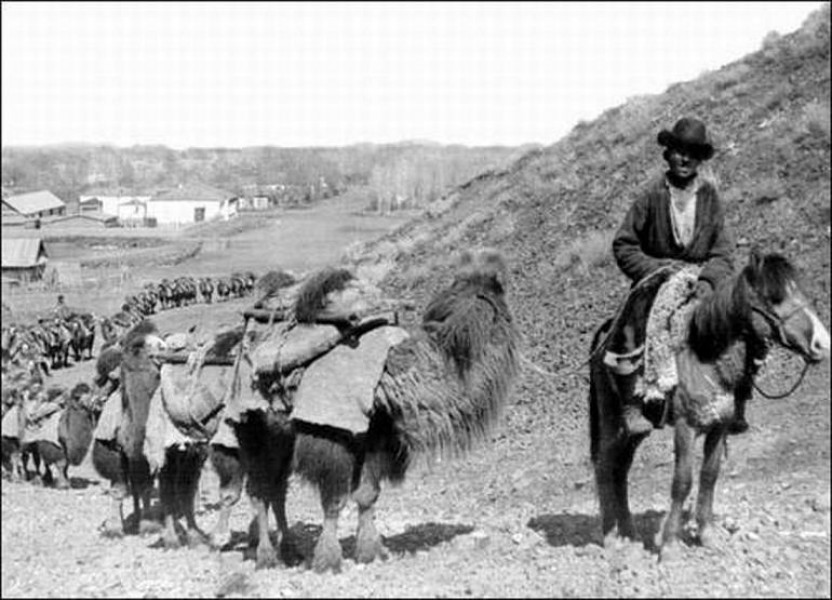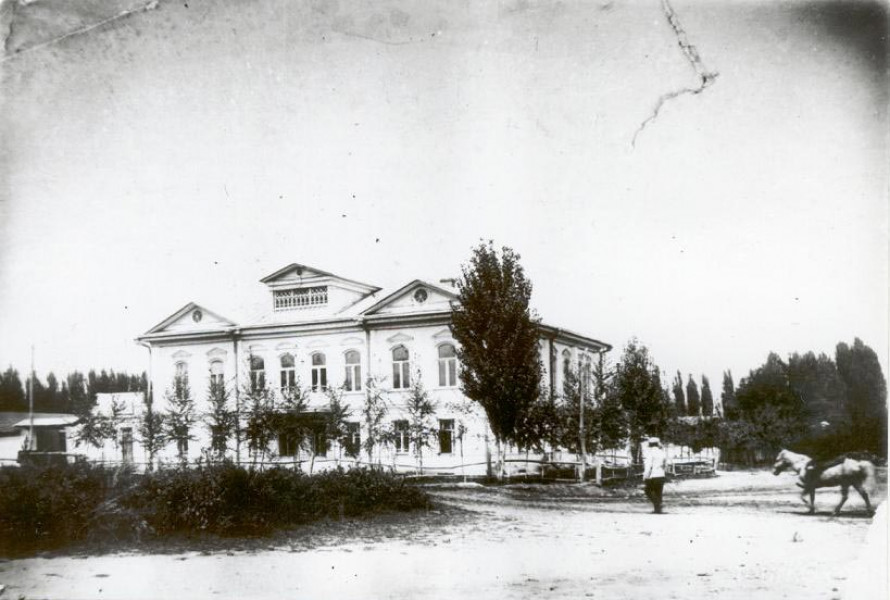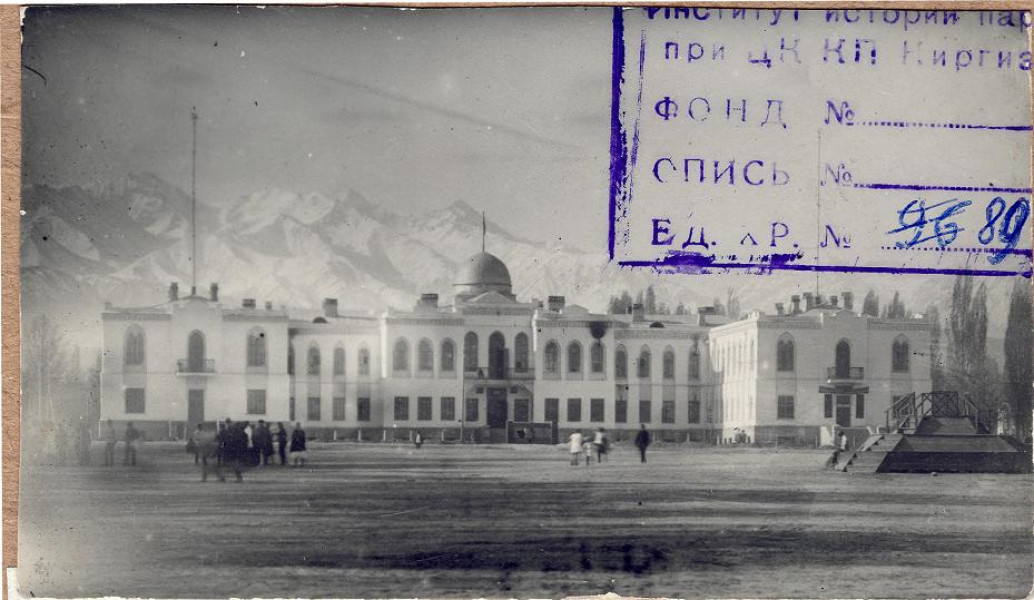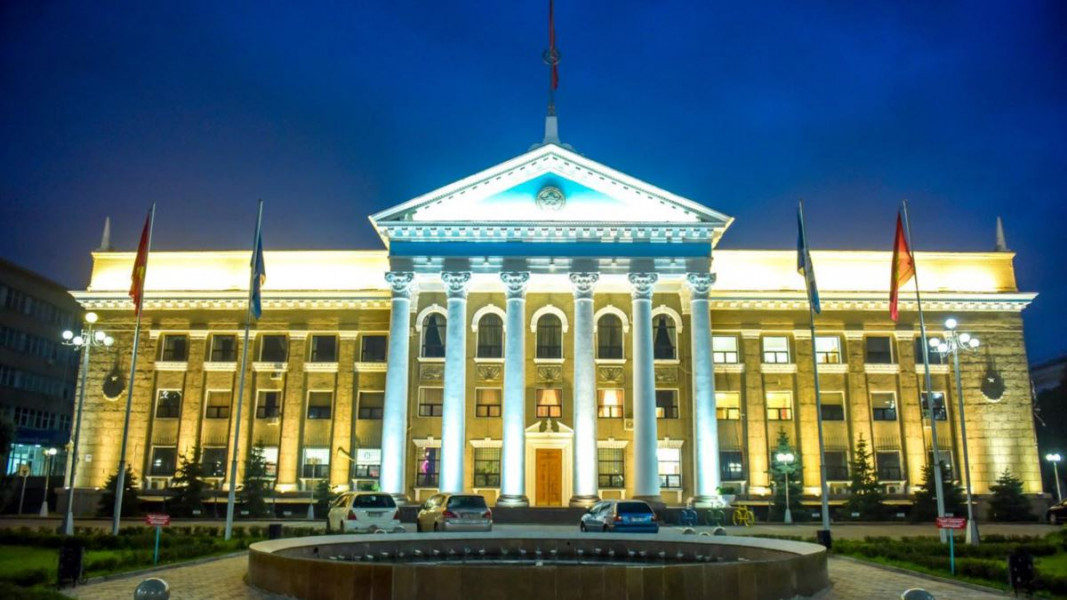History
The appearance of man on the territory of a modern city dates back to ancient times. The finds of stone tools at the Alamedin hydroelectric power station testify to the existence of primitive people in the vicinity of Bishkek in the 5-4 millennia BC. At the end of the 2nd millennium BC, tribes of the Bronze Age settled on the present territory of the city. They were engaged in herding cattle, agriculture, pottery and metallurgical crafts.
With the beginning of the Iron Age, tribal unions were formed on the territory of Kyrgyzstan: The Saka tribe (7-3 centuries BC) and Usun tribe (3 century BC - 5 century AD). The city of Bishkek owes its favorable geographical position to the Great Silk Road. Since ancient times, caravans have passed from China on two routes. The eastern branch of the road in a convenient place in the Zailiyskiy Alatau (via Kurdai) went into the Chuy valley and here it met another road leading through the Central Tien Shan, past Lake Issyk-Kul. Since ancient times, at the intersection of these routes, there was a caravanserai - a resting place for merchant people. Historically, it has been established that this area has long belonged to the one of the tribal clan of the Kyrgyz people - Solto. There was usually a lively trade along the roads in these places.
However, this juicy piece of land has always attracted conquerors and caused the temptation to take it over. A legend has survived, when innumerable hordes approached the intersection of two roads, the local residents were forced to flee to the mountains. But before the departure, the wife of one of the Batyr lost a whorl (in Kyrgyz - bishkek) for whipping kumys, hesitated to find it. And because she was in a delicate position and was very nervous, suddenly there was childbirth, she gave birth to a boy. He was named Bishkek, and he was a brave and strong horseman. His life is full of heroic deeds and pious deeds. And when he died on the bank of the Alamedin River, he was buried on the hill.
Somewhere between the modern eastern motor-coach terminal and the Issyk-Kul cinema, relatives and friends erected a gravestone gumbez-Bishkek. This structure was seen and described by the great travelers of the 17th-18th centuries. People settled in the interfluve of these wayward mountain streams in ancient times. On the territory of Bishkek, the remains of three cities were found, the life and prosperity of which was given by the Great Silk Road.
But it so happened historically that by the 16th century, trade and cultural ties between two civilizations - the West and the East - were finally interrupted. The legendary “silk road” ceased to exist, cities disappeared. Wars, plague epidemics, earthquakes have finally turned the once blossoming Chu valley into a desert. Urban life was replaced by another way of life - the way of life of nomads, who did not need to settle in one place. The once beautiful palaces and mighty castles, cheerful and noisy trade and craft caravans turned into swollen hills or even leveled off to the ground. The Chui valley between the Ala - Archa and Alamedin rivers for centuries became the winter pasture of the Solto tribe, one of the forty Kyrgyz tribes. Rare trade caravans from Central Asia to China through the Semirechye Kyrgyz and Kazakh nomads revived this rocky area.

Camel caravan on one of the passes of Semirechye. 1900th.
The interfluve of Alamedin and Ala-Archa is considered in many sources as a holy place. Springs with life-giving and healing water are mentioned, and other interesting facts are cited. And maybe that's why this area has become especially valuable and attractive for many nations. Therefore, outposts, a caravanserai and fortresses have been built here since ancient times. One well-known name before the emergence of the Kokand fortress, settlement or aul was called Dzhul.
However, according to written sources at times, the Kokand Khanate seized the territory of the interfluve and by order of Khan Modali in 1825 the fortress Pishpek was built here.
The Kokand people needed control over the movements of traders and nomads. The Bishkek fortress stood at the junction of nomads' paths from winter pastures to summer pastures and along the road to Issyk-Kul and Semirechye. Here, in the fortress, the Kokand people collected the customs tax from all caravans. The freedom-loving residents of Solta, led by their leader Baitik-Baatyr, have repeatedly tried to take and destroy the Bishkek fortress. But there was not enough artillery. The people of Kokand were not only strong, but also insidious. In the fortress, for example, relatives from noble Kyrgyz families were held hostage, including the son of Baytik Kanaev. In September 1862, the supreme leader of the Solto tribe, Baitik Kanayev, raised an uprising against the Kokand people, destroyed the commandant of the fortress Rakhmatulla and his convoy of 60 people and sent a messenger to the city of Verny for help from Russian artillery.
On October 13, 1862, the head of the Alatavsky district G.A.Kolpakovsky with a detachment of 1400 people and artillery began a complete siege of the fortress. On October 24 of the same year, the Kokand residents surrendered. On November 2, the Russian detachment left the remains of the fortress and went to the city of Verny. By order of Baitik-baatyr, the Kyrgyz completely destroyed the remains of the fortress in revenge on the Kokand people. One of the central streets of our capital (part of Sovetskaya Street) is now named after Baitik-Batyr. In 1863, the Kyrgyz up to Alai joined Russia. In Omsk, the Governor-General signed an agreement on joining Russia. Self-government is established in the region. In the Chui valley and near the ruins of the Bishkek fortress, a number of urban and agricultural settlements arose under the control of the tsar’s administration.
In 1868 – Lebedinovka valley, Novo-Pokrovka and 50 families settle on the post road line in the Pishpek tract. Thus, the Tashkent road became the first street of the future district town of Pishpek. Pishpek is the Kyrgyz name for the area Bishkek, misheard by Russian surveyor officers.
The first Russian peasant families from the Penza, Samara, Voronezh and Tambov provinces chose farmstead plots for themselves along the tract road, building at first dugouts and huts. Uzbek traders from Tashkent, Namangan and other regions of Uzbekistan joined the first settlers. Along the Alamedin River, the impoverished Kyrgyz people, who had no livestock and Uzbek gardeners, as well as families of the former garrison of the Kokand fortress of Bishkek, already lived there. By 1876, 58 families lived in Pishpek - 182 people of both sexes, including women - 94. By nationality, the inhabitants were divided as follows: there were 9 Russian families, 48 Uzbek families and 1 Tatar family.
That Pishpek only differed from the bulk of the Russian-Ukrainian villages in the region by its very favorable location and the presence of mail. The Pishpek fortress itself was destroyed, and its buildings on an ancient hill were leveled as unnecessary. There was no need for a military strengthening on the lands of the Kyrgyz people, since the relationship between the two peoples was laid on a peaceful basis. The first settlers dismantled the clay from the walls of the fortress for their buildings, so the first street was formed - the Tashkentskaya. The once formidable bastion of the Kokand people turned into a peaceful hill that hid the secrets of many centuries.
The Semirechye authorities planned to establish a district administration center in the north of Kyrgyzstan in Kochkork or Kutymaldy (Balykchi city), but the Turkestan governor-general, after a trip to Semirechye in 1870, chose Pishpek. On April 29, 1878, the district administration was located in Pishpek.
"The plan of the project location of the newly proposed city of Pishpek" - a city with buildings of the European type, was approved on August 31, 1878 by the military governor of the Semirechie region, Lieutenant General G.A. Kolpakovsky. The basic layout was simple and blended well with the surrounding area. Its street grid, broken in a checkerboard pattern, favored the arrangement of irrigation ditches and natural ventilation of the streets. The compact territory of the city between the rivers Ala-Archa and Alamedin was located in such a way that in terms of seismicity it was the most favorable area. Initially, the construction base in Pishpek was extremely primitive, there was not even a brick factory. A number of houses were built from centuries-old Tien Shan fir trees, the trunks of which were rafted from gorges along mountain rivers, most of the houses were literally "molded" from clay. Russian, Ukrainian, Moldovan immigrants learned from the local residents Asian methods of house building. The city was clay, but its layout turned out to be progressive in its essence. It was one of the first cities of the European type with an incomparably higher level of development of Russian urban planning art. And the traditions of this layout have been preserved and improved in modern Bishkek.
The only adornment in that small adobe Pishpek was the magnificent panorama of the mountains of the Kyrgyz Ala-Too. Its highest peaks rise as an ice ensemble over the interfluve of Ala-Archa and Alamedin. What the valley was like at that time can be seen on the small canvases of the Russian officer and outstanding artist V.V. Vereshchagin, who visited these places with an expedition of military topographers in the 19th century. These small masterpieces, witnesses of Kyrgyz history are exhibited at the KSMII named after G. Aitieva.
Gardens and parks became the second decoration of Pishpek. It is hard to believe now that the city was founded in a semi-desert. Here is the evidence of that time: "... only a few scattered houses here and there, ... and further behind them into the distant space stretched naked, barren dead steppe with hot sands and stones ...". F. Poyarkov.
The city administration and ordinary citizens did their best to turn Pishpek into a garden city. Each city dweller was obliged to plant at least 25 trees along the street next to the house, each visiting merchant was obliged to allocate funds from the income of his trade for landscaping Pishpek. One of the best amateur gardeners was a native of Namangan Selim Raimbayev, who had a large garden in the Alamedin tract since the 40s of the 19th century and subsequently supplied the Pishpek new settlers with seedlings of fruit trees and thaw.
The pioneer of cultural gardening and artificial afforestation in the region was the Pishpek gardener A.N. Fetisov, founder of the Karagachevaya Grove in 1881. At the same time, the first planning of streets and squares was carried out, places were allocated for housing, government buildings and barracks, as well as for trade, forges and other craft establishments.
In the late 19th and early 20th centuries. in Pishpek there were already 40 streets (without hard cover and sidewalks), 6 large squares (uncomfortable and dirty). The acquisition of city status contributed to the growth of Pishpek. The first handicraft enterprises appeared in Pishpek in the second half of the 19th century. In 1883, a tannery began to work, and in 1885 a cheese-making production was organized. All power in Pishpek and the district was with the district chief, and since 1895 the city's economy was in charge of public self-government from the Pishpek bourgeoisie, dependent on the tsarist authorities. Contrary to the policy of tsarism, aimed at limiting the development of the culture of the peoples of the national borderlands, the first cultural and educational institutions, schools, and hospitals appeared in Pishpek.
Representatives of the progressive Russian intelligentsia left a memorable trace in the history of the city. Among them - the first paramedic V.M. Frunze, in whose family on January 21, 1885, a son Mikhail was born - the future party, state and military leader; scientist gardener A.M. Fetisov, head of the Kyrgyz school of gardening.

House of Pishpek elder Ilya Fedotovich Terentyev, photo 1914
An economic committee was created from wealthy homeowners and merchants, headed by officials of the county administration. The volost administration of the lands adjacent to the city was headed by Uzbek Boshkoev - the nephew of the famous Baitik-baatyr and a participant in the military campaigns of General Chernyaev to Tashkent. Uzbek Boshkoev was the grandfather of the ideological founder of modern Kyrgyz statehood, Abdykerim Sydykov. The city was a commercial one, but there was also an intelligentsia here: The Terentyev family, doctor F.V. Poyarkov, paramedic V.M. Frunze, teacher of the gymnasium K.F. Svirchevsky, the irrigator Vasiliev and others who brought all the best from European civilization to this region. Outstanding travelers drove through the city and stayed here: I.V. Mushketov, N.M. Przhevalsky, Delmaz Morgan, Capyu, Bonvalo, Blank. At the same time, the Kyrgyz intelligentsia rose as well. The children of major Kyrgyz traders and industrialists have already studied at Russian gymnasiums and universities. The city acquired a permanent connection with European civilization through the telegraph and post office. Pishpek joined the same historical events that ruled the entire continent. And it is no coincidence that our city was one of the first to peacefully accept Soviet power. Here, on the outskirts of the Russian Empire, the significance of the October Revolution was well understood.
Immediately after the February events of 1917 in Russia, after the abdication of Tsar Nicholas I from the throne, here, in distant Pishpek on March 31, 1917, the Pishpek Soviet of Soldiers, Officers and Workers' Deputies was created. The group of Bolsheviks was strong in the city and district. On January 1, 1918, the Bolshevik G. I. Shvets-Bazarny (the first Soviet mayor of the city) was elected chairman of the Pishpek Soviet, and a resolution was adopted recognizing the central Soviet power.
But by December 1917, the entire Semirechye was engulfed in a White Cossack rebellion. On December 14, 1917, armed detachments of White Cossacks and leftist essers from the village. Belovodskoe broke through to Pishpek and occupied its western part. The White Cossacks had far-reaching plans for the creation of an "independent Cossack Semirechye republic" without the Bolsheviks, the tsar, the "devil" and the Kirghiz. And the peaceful city of Pishpek, lying on the way between Tashkent and Verny (Almaty), was a "stumbling block" for the implementation of these plans.
The city was defended by the 1st Pishpek regiment under the command of Y.M. Logvinenko, who arrived from the Northern Semirechie front. By December 28, the entire district was cleared of counter-revolutionaries. The first people who died in the struggle for the power of the people were buried on January 1, 1919 in the center of Pishpek, in an oak park, near the Nicholas Church, where a rally under the slogan "For the power of the Soviets" was once held. Nowadays a 2-meter granite obelisk rises above a small mound of a mass grave with four cannons.
The entire people of Kyrgyzstan, raised by the Revolution, rushed to a new life. A few days after the establishment of Soviet power, on November 16, 1917, the "Declaration of the Rights of the Peoples of Russia" was published, signed by V. Ulyanov (Lenin). The Declaration proclaimed the equality and sovereignty of the peoples of Russia, their right to self-determination, up to and including secession.
With great enthusiasm, all the progressive people of Kyrgyzstan embraced this opportunity to create an independent statehood. The best minds of the Kyrgyz intelligentsia took an active part in the practical implementation of this idea. A. Sydykov, I. Arabaev, D. Sooronbaev and others, already in the summer of 1917, even before the October Revolution, united for the concrete formulation of the idea of Kyrgyz statehood. Not everyone was able to see the fruits of their ideas. In the 1920s and 1930s, in a latent, difficult internal political struggle, national state associations of the huge Union were created.

The building of Sov.Nar.Kom, built in 1928 according to the design of Zenkov
And, most importantly, the dream of these extraordinary people has come true. Gradually, with tremendous efforts, and at the same time with great spiritual upsurge, the Kyrgyz statehood was created, the modern economy was formed, and the Kyrgyz culture developed. From feudalism, in just a few decades, Kyrgyzstan stepped into a new society, taking a worthy place in modern civilization.
The former small county town of Pishpek became the political and economic center of the great transformations.
October 14, 1924 Pishpek is the center of the Kara-Kyrgyz Autonomous Region. February 1, 1926 Pishpek is the capital of the Kyrgyz ASSR. On May 12, 1926, the Presidium of the Central Executive Committee of the USSR approved the name of Frunze for the city of Pishpek. Since December 5, 1936, Frunze is the capital of the Kyrgyz SSR. Frunze is a flourishing land with a powerful diversified industry, highly developed mechanized versatile agriculture. The former wilderness province, which did not even have country roads before the revolution, was covered with a network of asphalted highways and steel highways. In the sky, there were routes of local and allied airlines that connected the capital of the republic - Frunze with Moscow, Leningrad, Sverdlovsk, Novosibirsk and other cities of the former union.
The science and art of the Kyrgyz people achieved unprecedented development, their literature and cinematography received world recognition. The level of well-being of the working people of Kyrgyzstan has grown immeasurably. Deprived of basic amenities before the revolution, former nomadic pastoralists and their descendants live in beautiful modern cities and villages, enjoying all the benefits and achievements of civilization. The majestic transformations that the working people of the republic are making reveal new qualities of people, new phenomena characteristic only of socialist reality, forming a multi-colored picture of the present life of the republic, where representatives of more than 80 nations and peoples of our country live and work as a single family, where they develop and bear wonderful fruits the best, carefully preserved national traditions, enriched by the experience of the fraternal international community. In accordance with the Constitution, the Kyrgyz Republic is a sovereign unitary democratic republic, built on the basis of a lawful secular state. Bishkek is its capital.
In April 1991, the Supreme Soviet of the SSR made a decision to rename the city of Frunze. The city was returned to its ancient original name.
Bishkek today
Today Bishkek is the capital, soul and heart of the Kyrgyz Republic, its political, economic, scientific and cultural center, the main transport hub. Now our city is all in a fit for a new life. It is rapidly transforming in a free enterprise environment. Territory area - 160 sq. km., population - about 1 million people. Bishkek is the location of the highest state authorities of the republic, embassies of foreign states. Most of the entire industry of Kyrgyzstan is located in Bishkek. The most intensively developing industries are mechanical engineering, production of textiles, building materials and food processing. International airport "Manas", located 30 km from the city, has the prospect of becoming a major transit port for air traffic between Western Europe, Central and Southeast Asia, the Middle and Far East, Oceania, North Africa. This is confirmed by the air corridor agreement recently signed by the governments of Kyrgyzstan and China, as well as large investments by Japanese and German firms in the reconstruction of Manas airport.
The information infrastructure of the city is rapidly developing: several Internet providers are working, a large number of local, global, corporate computer networks have been created, a number of cellular operators are working.
The city has representative offices of such large international companies as Deloitte, KPMG, World Class, Forever Living Products, Hyatt, Sheraton, Novotel, Centerra Gold, BMW, Toyota, Lexus, Mercedes-Benz, Audi-VW Group, Renault, Hyundai Motors, Sumitomo, Federal Express, DHL, UPS, LG-Electronics, Daewoo, Phillips, Coca-Cola, PepsiCo, Beeline, Gazprom, ABB, Grata International and Samsung etc.
The banking system includes 21 banks connected by correspondent relations with the largest foreign banks. Several banks are included in the international payment systems Visa, Master Card and EUROPAY. A national system of cashless payments has been formed.

Science and education are represented by the National Academy of Sciences and a large number of secondary and higher educational institutions. 18 universities, 20 institutes, 9 academies.
Bishkek is the center of national culture of Kyrgyzstan. It houses music and drama theaters, the Philharmonic, libraries and museums. The city is beautiful in all seasons.
Bishkek, being the center of international tourism in Kyrgyzstan, can offer tourists a large number of attractions. The main and favorite place for recreation and walking of guests and tourists of the capital is the center of Bishkek. Most of the museums, galleries, shops, parks, squares, squares, restaurants and cafes are concentrated here.
The city of politicians and bankers, entrepreneurs and students, scientists and artists is looking to the future. It looks like a white sacred falcon depicted on the country's coat of arms, spreading its wings over the whole of Kyrgyzstan.
